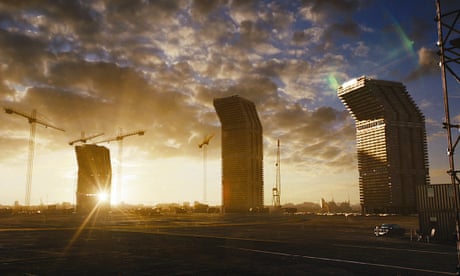Ben
Wheatley’s weird, ambitious new feature “High Rise” (based on the 1975 novel by
famed post-modern author JG Ballard) certainly sticks with you long after the
end credits. It’s a surrealistic black comedy and a macabre nightmare about
urban living rolled into one.
As
the title suggests, most of the action takes place at a massive high-rise
apartment building. While located in London, the building is nevertheless
isolated from the rest of the city. With its slanted and jagged modern art
design (inside doorways and archways are mostly triangular in shape), the
building is luxurious and welcoming. At the same time, it’s overwhelmingly grey
in color (the entire building is made of concrete) and the barren, shabby
parking lot surrounding it makes the structure look like an ominous, rundown
prison. In fact, as the film goes on, “prison” becomes a more apt term to
describe the building rather than “luxury high rise” and both the residents
trapped inside the building and the viewer experience an intense feeling of
claustrophobia.
In
England during the 1950’s, 60’s and 70’s, there was a boom in high-rise
construction. These structures were meant to exhibit post-war progress and
modernity; instead they were a hassle. Often times they were cheaply and
hastily made, leading to frequent maintenance problems. There were also issues
of security (break ins, vandalism etc.) and an unpleasant feeling of isolation;
residents felt cut off from society.
Ballard’s
original novel was clearly addressing this unsavory situation, however, the
book (as well as the movie) goes much further by presenting a far more bleak, apocalyptic
vision of high-rise living and modern life in general. This state of the art
structure, that’s supposed to signal progress, causes societal regression and
the de-evolution of our species. Bleak
indeed.
Complementing this apocalyptic viewpoint is the film’s overt
themes of class division and warfare. Due to its all-inclusive nature (a
shopping mall, swimming pool and even a school are included) the building
becomes a microcosm for society, with the wealthier residents living on the top
floors and poorer residents near the bottom. In between lies the film’s
protagonist Dr. Robert Laing (Tom Hiddelson, equal parts understated and
sinister) the building’s newest resident, who makes friends from both the lower
and higher floors, most notably Anthony Royal (Jeremy Irons) the building’s
architect and “ruler” of sorts. The upper floor residents are grotesque
caricatures of wealthy people, who frequently throw elaborate parties
(involving booze and orgies) that take power away from the lower floor rooms. This
tension between the upper and lower floor residents drives the action of the first
half.
Can the movie feel a little too blatant and heavy-handed?
Yes. Wheatley hits the “building-is-society” and “class divide” themes pretty
hard talking down to his audience in the process. The screenplay by Amy Jump
contains some stupid, ham-fisted dialogue that tends to over explain and snaps
you out of the moment. For example, during a scene where Laing is walking up
the stairs, he’s stopped by a wealthy tenant who says, “Social climbing…are
we?” And later on Laing tells Royal right out: “you hold the key to the
building…symbolically.”
However, “High Rise” remains watchable thanks to its sheer nuttiness
and unpredictability. The film is a hypnotic fever dream that becomes more
delirious and dislocated from our reality with each passing minute. The focus
shifts from class warfare to chaos and anarchy, a trajectory that proves to be
far more compelling and terrifying than a simply rich vs. poor conflict because
there are no clear-cut good and bad guys.
Everyone, upper floor and lower floor, goes mad-- reverting
back to savagery, roaming around in small factions causing damage and mayhem. Socioeconomic
status becomes superfluous. The building itself eventually loses power for
good while the hallways and corridors become trashed. The once luxurious, all-inclusive
high rise is now a disheveled industrial ruin populated by deranged squatters
who seem to have no regard for one another. In this feverish state, the picture
inspires both moments of inspired, twisted humor and horror in equal measure. A
rape sequence (or rather the moment right before the rape and after) involving two
supporting characters that used to be friends is genuinely disturbing and icky.
“High Rise” can be repetitive and tedious; there are too
many slow motion party/orgy montages that cause the film to drag every now and
then. Additionally, some people may find the movie difficult to enjoy because
Laing and the rest of the residents are so emotionally distant as characters. There
isn’t anyone you can fully connect or sympathize with mainly because they don’t
connect or sympathize with one another, especially when all hell breaks loose.
Even so, Wheatley has crafted a bizarre, thought provoking
feature about modernity and urban living gone horribly wrong.



